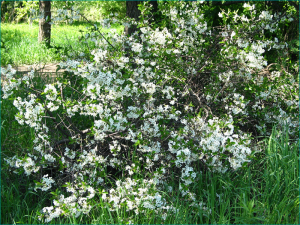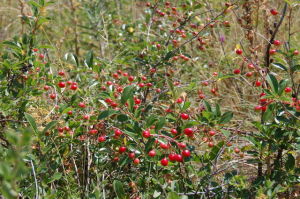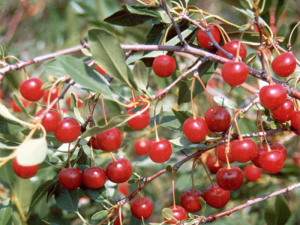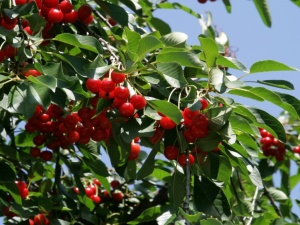Shrub cherry, or steppe - rules of care
Steppe cherry is very popular among gardeners and is distributed over vast territories of Russia, due to the greatest, among cherries, drought resistance and winter hardiness. It is one of the few bush varieties that can withstand harsh winters without shelter.
Content
Description of the species
Appearance
Steppe cherry belongs to undersized shrubs. An adult bush has a height of 0.5-1.5 meters. It mainly reproduces by basal shoots, very rarely by cuttings. An adult plant has long branching roots with numerous branching offsets. The distance between adjacent shoots at the root is about 70-90 cm. Young offspring are reddish-brown in color, elongated, monopodial in shape. Their aboveground part is covered with lanceolate, scaly leaves, which die off in the process of further growth of the shoot.
Adult trunks have dark gray bark. They are erect, branched, covered with scattered hairs during the period of active growth, become bare over time. The foliage is oblong, 8-16 mm long, depending on the age of the shoot, it has a more rounded oval or lanceolate shape. Leaves are smooth dark green, lighter below, pinnate.
The distribution area runs from North Asia and Siberia to Western Europe. It is not uncommon in Italy, southern Germany and central Poland.

Flowering and fruits
Blooms profusely. The flowers are small, collected in 3-5 umbellate inflorescences or single, appear simultaneously with the leaves or before they bloom. Shrub cherry on the garden plot looks attractive and picturesque, has a low growth rate. Refers to partially self-fertile varieties, therefore, other pollinating varieties should be planted nearby to obtain ovaries.
The berries of the steppe cherry, as a rule, are small, in rare grafted varieties they are of medium size, dark red or red in color with a dense skin. They have a sweet-sour, watery taste. Shrub cherry is very susceptible to fungal diseases, in particular to coccomycosis. In the photo you can see the shape of the berries and leaves, the appearance of the bush, in general.

Varieties
For the convenience of gardeners, below is a description of the most common varieties of steppe cherry.
Generous
The height of the bush reaches 2.3 meters, has a wide, spreading shape with upturned shoots, medium foliage. The leaves are elongated, shiny, dark green.
In inflorescence 3-4 flowers, corolla, opened in diameter 20 mm. Fruiting on annual growth and bouquet branches. The berries are medium large, weighing 3-4 g, dark red, resistant to cracking. They have a sweet, watery taste. The separation from the peduncle is dry.
Refers to self-fertile varieties. The flowering period is medium, May 18-25. Fruits ripen late, not at the same time, in the second half of August. Begins to bear fruit from 3-4 years. The yield is high, annual. Taking into account regular anti-aging pruning and proper feeding, this variety is relatively durable - up to 32 years.
Has high winter hardiness and drought resistance. Flowers and buds are resistant to spring frost.
Bolotovskaya
Shirokokrugly, spreading bush up to 1.7 m tall. Leaves are glossy, bright green, elongated, oval in shape. 4 flowers per inflorescence. Fruits are large, 4-4.5 g, rounded, dark red. The pulp is of medium density, red, juicy, sweet and sour.Berries are resistant to cracking.
Refers to highly self-fertile varieties. The period of flowering and fruit ripening is medium late. The berries ripen in the first part of August. Fruiting from 2-3 years, with proper and timely care for more than 30 years in one place. Drought-resistant. Winter hardy. Susceptible to fungal diseases. The yield is high.
Ashinskaya
Tree-like, fast-growing, up to 2.2-2.7 m high. The crown is conical, medium thickened. The leaf is dark green, oblong, rounded, narrow oval, curved upward, the petiole is short. The flowers are small, 5-6 per inflorescence, the peduncle is short.
Fruits are large, weighing 4-4.5 g, dark red juicy, dense skin. Resistant to cracking. The taste is sweet and sour. Ripen late, in early August. The variety is partially self-fertile. The flowering period is medium, extended. Fruiting for 4-5 years, up to 30 years in one place. Average frost resistance. High resistance to fungal diseases. Drought-resistant. The yield is high, annual.
Maksimovskaya
Cherry Maksimovskaya, like Irtyshskaya, has a multi-stemmed bush, up to 1.5-1.8 m high. The crown is medium thickened, pyramidal. Branches are light brown, spreading, smooth. Leaves are shiny, light green, short-pointed, rounded, oblong.
The flowering period is average. The berries are large, red, oblong-rounded, with long stalks. Ripen in mid-July. They have a sweet and sour taste, juicy. The annual yield is high.
Drought resistance and winter hardiness are high. Propagated by cuttings, little root shoots.
The desired
The bush is medium-sized, up to 1.5-1.7 m high. The crown is medium thickened, wide, raised. Shoots and branches, brown, covered with small lenticels and gray bloom, drooping. The leaves are elongated, pointed, light green in color, the petiole is short.
The flowering period is early. Medium-sized berries 3-3.4 g, dark red or red, ripen in the second half of July. The yield is high, annual. Fruiting begins in 2-3 years. Drought resistance and winter hardiness are high. This variety is resistant to damping off. Forms little root growth, propagates by cuttings.

Growing features
Planting and fertilizing
Planting and leaving is, first of all, in choosing the right place. Steppe cherry does not bear fruit well and often turns white in a shaded area; a sunny place is chosen for it, where in winter the snow level does not exceed 70-90 cm, since part of the bark in the root zone can undermine when the snow melts. You can reduce the risk of damping by planting cherries on small mounds or ridges. This variety is not whimsical to the soil, however, it is worth giving preference to medium and light sandy loam.
Before planting, it is imperative to add to the depth of the roots of humus 4-5 kg per m2, potash and phosphorus fertilizers, dissolving them in 15-20 liters of water. This will allow you to get high yields in a short time already next year. Steppe cherries are planted in early spring, when the soil thaws and warm, constant weather sets in. During the growing season, feeding with superphosphates is required. During the period of intensive growth, 2-3 abundant watering should be carried out, in the amount of 3-5 buckets for each bush. The first watering is carried out immediately after flowering, combining it with top dressing, the second - after the fruit ovary, during their ripening.
Chemical processing and pruning
Since steppe cherry mainly bears fruit on annual branches, a decrease in its growth leads to a significant decrease in yield and shrinking of fruits. With regular, timely pruning, cherries can bear fruit abundantly in one place for 18-20 years.
The bush is thinned out, leaving no more than 8-14 branches with developed lateral branches. It is necessary to remove damaged, dried branches - a source of reproduction and wintering of the disease. To increase the yield and quality of berries, remove excess root shoots and branches older than 7-8 years, under the ring. Leave 3-4 root branches annually.Do not under any circumstances shorten annual shoots.
Since the steppe cherry has a high tendency to fungal diseases, for prophylaxis during the flowering period, a mandatory first spraying with special preparations is carried out. And repeat 2-3 treatments every 7-10 days.
Video "Shrub cherry, or steppe"
This video highlights the features of fruiting, care and planting of this variety.
